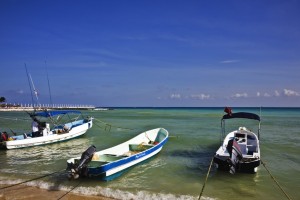Northern Baja California Fishing
- Last Updated: February 16, 2023 by Mike Mercer
- Categories:
- Activities, Baja, Fishing

Fishermen's Road trip
A Fishermen's Road trip around the northern half of Mexico's Baja Peninsula could be a great way to spend your next vacation. Both the Pacific Coast and the Sea of Cortez offer a plethora of opportunities to catch a many different species of bottom fish and sport fish. Some species bite more often during certain times of the year. If you are looking to hook a specific type of fish, you'll want to do a little research to find out when it will be in season; otherwise, fishing around the Baja is a great year round activity.
Ensenada
Ensenada, located in the protected harbor of Bahía de Todos Santos, and is approximately 70 miles from the U.S. border at San Diego. It is the third largest city in Baja California, along with being its busiest seaport. Around 1950 Ensenada began to publicize itself as the "Yellowtail Capital of the World," but today the locals still prefer to call it "La Cenicienta del Pacífico" (The Cinderella of the Pacific). There are literally hundreds of species of fish that live in the waters near Ensenada, but some of the more common catches include: Yellowtail, Mackerel, Yellowfin Tuna, Calico Bass, Rock Cod, Red Snapper, Whitefish, Bonito, Barracuda, and Salmon Grouper.
San Felipe
San Felipe is about a 130 mile drive from the U.S. border at Calexico, and is situated on the Bay of San Felipe in the Gulf of California (Sea of Cortez). The little town, founded in 1916, was originally built up around fishing camps, but by the late 1940s it began being transformed into an international tourist center. Lots of different fish species are regularly caught in the waters around San Felipe, but some of the more notable catches include: Yellowtail, Mahi-mahi, Corvina, Red Snapper, Whitefish, Sheepshead, Spotted Bass, White Sea Bass, Black Sea Bass, Sierra Mackerel, Triggerfish, Roosterfish, Grouper, Rock Cod, Mexican Sea Bass, and Marlin.
San Quintin
San Quintin is a small town located on the west coast of the northern Baja California Peninsula, near the Bahía de San Quintín, one of the largest bays on the western Baja. In the 1880s the town began being built up for large scale wheat production and export. The crops were devastated by drought and by 1900 the wheat cultivation operations were abandoned. Today, agriculture still remains important in San Quintin, with tomatoes and strawberries being the primary crops. San Quintin is less than a four-hour drive from the U.S. border at San Diego. There is an abundance of species that live in the waters near San Quintin, but some of the most commonly caught types include: Yellowfin Tuna, Red Snapper, White Striped Bass, Black Sea Bass, Mahi-mahi, Halibut, Albacore, Rock Cod, Barracuda, and Marlin.
Bahia de Los Angeles
Bahia de Los Angeles, located on the Sea of Cortez, is said to be one of Mexico's most beautiful bays. The area may be reached by car and is just over 400 miles from the U.S. border at San Diego. The Cochimi Indians, dating back 14,000 years, were the original inhabitants of the area. The first European discoverer, Francisco de Ulloa, arrived at the bay in 1539. However, the town was not established until over 200 years later, in 1746, during a subsequent exploration by the Spanish Jesuit missionary Fernando Consag, who had been sent to test the incorrect theory that the Baja Peninsula was an island. Bahia de Los Angeles has become famous for great fishing, and the tiny town's economy depends largely on both fishing and tourism. Some common species of fish that you may be able to hook in and around the bay include: Yellowtail, Sea Bass, Red Snapper, Sierra Mackerel, Grouper, Bonito, Barracuda, Triggerfish, and Mahi-mahi.
Getting a Fishing License
If fishing gear is on the boat, a fishing license is required for every person on the boat, even if only one person or no one is fishing. It is also required if you are spearfishing. If you are fishing on land, even if wading, you do not need a fishing license. Learn everything you need to know about fishing legally in Mexico here on our blog.
Driving in the Baja
All of the Baja Peninsula is within Mexico's Free Trade Zone, also known as the "Hassle Free Vehicle Zone." Within the free zone, you are not required to purchase a Mexico temporary vehicle import permit. However, should you decide to arrange a ferry ride across the Gulf of California, over to mainland Mexico, you will very likely need to secure a permit. Whether you are planning to use your car, truck, SUV, motorcycle, or RV, for your next Baja fishing road trip, do not neglect to purchase Mexico tourist vehicle insurance. The Mexican authorities will not recognize your U.S. liability insurance coverage, and if you are involved in an accident they will want to see a policy that has been issued by a recognized Mexican insurance company.
